NCERT Solutions for Class 11 Maths Chapter 1 Sets Ex 1.2
Get Free NCERT Solutions for Class 11 Maths Chapter 1 Sets Ex 1.2 PDF in Hindi and English Medium. Sets Class 11 Maths NCERT Solutions are extremely helpful while doing your homework. Sets Exercise 1.2 Class 11 Maths NCERT Solutions were prepared by Experienced LearnCBSE.online Teachers. Detailed answers of all the questions in Chapter 1 Class 11 Sets Ex 1.2 provided in NCERT Textbook.
- Class 11 Sets Ex 1.1
- Class 11 Sets Ex 1.1 in Hindi Medium
- Class 11 Sets Ex 1.2
- Class 11 Sets Ex 1.2 Hindi Medium
- Class 11 Sets Ex 1.3
- Class 11 Sets Ex 1.3 Hindi Medium
- Class 11 Sets Ex 1.4
- Class 11 Sets Ex 1.4 Hindi Medium
- Class 11 Sets Ex 1.5
- Class 11 Sets Ex 1.5 Hindi Medium
- Class 11 Sets Ex 1.6
- Class 11 Sets Ex 1.6 Hindi Medium
- Class 11 Sets Miscellaneous Exercise
- Class 11 Sets Miscellaneous Exercise in Hindi Medium
- Sets Class 11 Notes Maths Chapter 1
- NCERT Exemplar Class 11 Maths Chapter 1 Sets
- RD Sharma Class 11 Solutions Chapter 1 Sets
- Chapter 1: Sets Class 11 NCERT Book
- अध्याय 1: समुच्चय Class 11 NCERT Book
Free download NCERT Solutions for Class 11 Maths Chapter 1 Sets Ex 1.2 PDF in Hindi Medium as well as in English Medium for CBSE, Uttarakhand, Bihar, MP Board, Gujarat Board, BIE, Intermediate and UP Board students, who are using NCERT Books based on updated CBSE Syllabus for the session 2019-20.
Class 11 Maths NCERT Solutions Chapter 1 Sets Ex 1.2
Q.1: Which of the following given below is null set?
(i). Set of odd natural numbers which is divisible by 2.
(ii). Set of even numbers which are prime
(iii). {x: x is a natural number,
x
<
5
and
x
>
7
}
(iv). {y: y is a point common to any two parallel lines}
Solution:
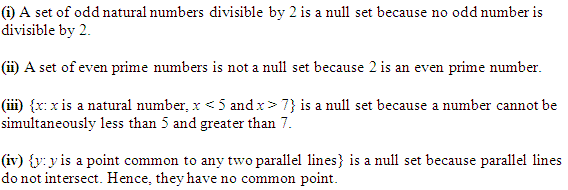
Q.2: State whether the following sets are infinite or finite:
(i). A set of months of a year.
(ii). {1, 2, 3 ….}
(iii). {1, 2, 3…99, 100}
(iv). The set of positive integers which are greater than 100.
(v). The set of prime numbers which are less than 99
Solution:
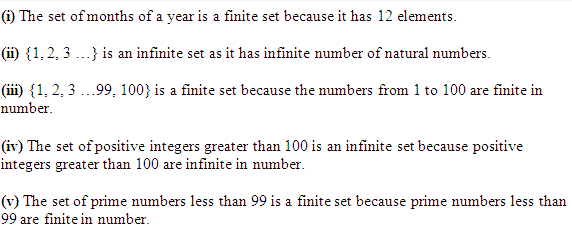
Q.3: State whether the following sets are infinite or finite:
(i). The set of lines parallel to the x – axis.
(ii). The set of letters in the vowels.
(iii). The set of numbers multiple of 10.
(iv). The set of humans living on Earth.
(v). The set of circles passing through the origin (0, 0).
Solution:
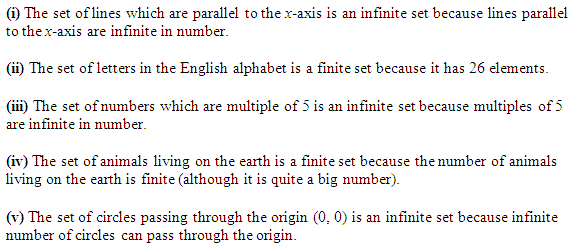
Q.4: In the following set given below, state whether A = B or not:
(i). A = {w, x, y, z}
B = {z, y, x, w}
(ii). A = {5, 9, 13, 17}
B = {9, 5, 17, 19}
(iii). A = {4, 2, 6, 10, 8}
B = {x: x is positive even integer and
x
≤
10
}
(iv). A = {x: x is a multiple of 10}
B = {10, 15, 20, 25, 30 …}
Solution:
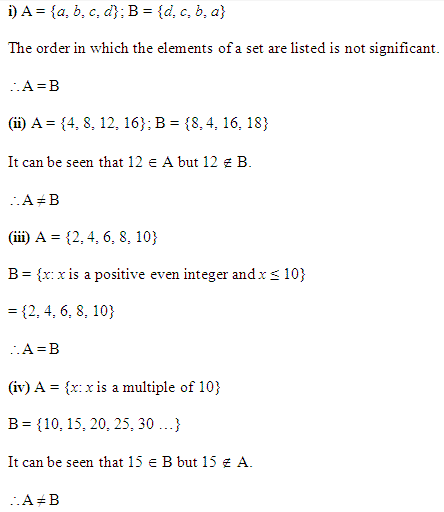
Q.5 In the following set given below, is the pair of sets equal?
(i). A = {3, 4}
B = {y: y is solution of
y²
+
5
y
+
6
=
0
}
(ii). A = {a: a is a letter in the word FOLLOW}
B = {b: b is a letter in the word WOLF}
Solution:
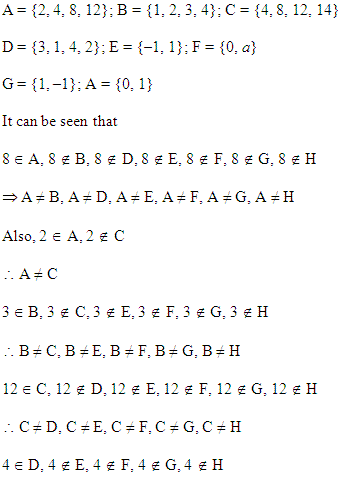
Q.6: From the following sets, select equal sets:
A = {2, 4, 8, 12}
B = {1, 2, 3, 4}
C = {4, 8, 12, 14}
D = {3, 1, 4, 2}
E = {–1, 1}
F = {0, a}
G = {1, –1}
H = {0, 1}
Solution:
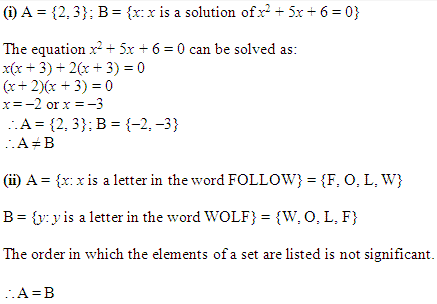
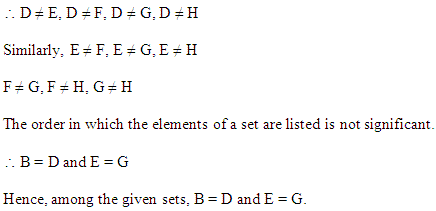
NCERT Solutions for Class 11 Maths Chapter 1 Sets Ex 1.2 in Hindi
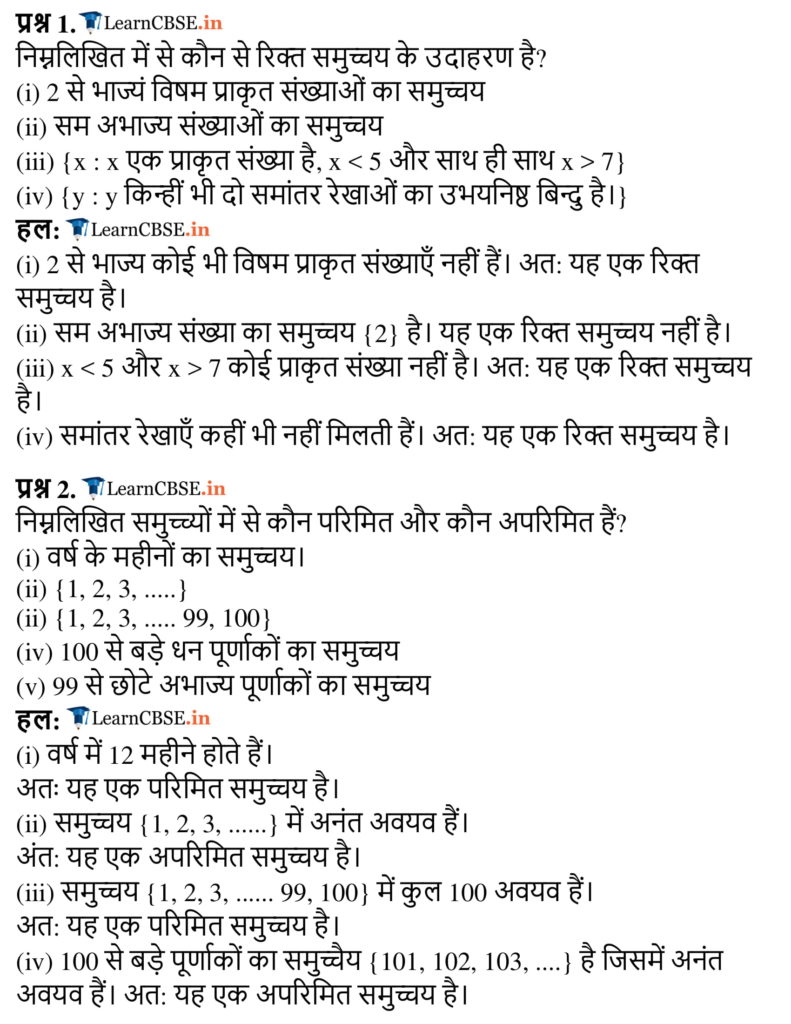
(v) 99 से छोटे अभाज्य पूर्णांकों का समुच्चय {2, 3, 5, 7, …… 97} है जिसमें अवयवों की संख्या निश्चित है।
अत: यह एक परिमित समुच्चय है।
प्रश्न 3.
निम्नलिखित समुच्चयों में से प्रत्येक के लिए बताइए कि कौन परिमित है और कौन अपरिमित है?
(i) x-अक्ष के समांतर रेखाओं का समुच्चय।
(ii) अंग्रेजी वर्णमाला के अक्षरों का समुच्चय।
(iii) उन संख्याओं का समुच्चय जो 5 के गुणज हैं।
(iv) पृथ्वी पर रहने वाले जानवरों का समुच्चय
(v) मूल बिन्दु (0, 0) से होकर जाने वाले वृत्तों का समुच्चय।
हल:
(i) x-अक्ष के समांतर अनंत रेखाएँ खींची जा सकती हैं। अत: यह एक अपरिमित समुच्चय है।
(ii) अंग्रेजी वर्णमाला में कुल 26 अक्षर होते हैं। इन अक्षरों से बनने वाला समुच्चय परिमित होगा।
(iii) 5 से विभाजित होने वाली संख्याओं का समुच्चय {5, 10, 15, 20, ….} है, जिसमें अनंत अवयव हैं। अतः यह एक अपरिमित समुच्चय है।
(iv) पृथ्वी पर रहने वाले जानवरों का समुच्चय परिमित होगा।
(v) मूल बिन्दु को केन्द्र मानकर अनन्त वृत्त चे जा सकते हैं। अत: यह अपरिमित होगा।
प्रश्न 4.
निम्नलिखित में बताइए कि A = B है अथवा नहीं है।
(i) A = {a, b, c, a}, B = {a, c, b, a}
(ii) A = {4, 8, 12, 16}, B = {8, 4, 16, 18}
(iii) A = {2, 4, 6, 8, 10}, B = {x : x सम धन पूर्णाक है और x ≤ 10}
(iv) A = {x : x संख्या 10 का एक गुणज है}, B = {10, 15,20, 25, 30, …}
हल:
(i) A और B दोनों समुच्चयों के अवयव a, b, c, d हैं अतः A = B.
(ii) A में अवयव 12 है परन्तु B में नहीं है अतः A ≠ B.
(iii) A और B दोनों समुच्चयों में अवयव 2, 4, 6, 8 और 10 हैं। अतः A = B.
(iv) A = {10, 20, 30, 40, …..}, B = {10, 15, 25, 30, ….}
10 के गुणजों में 5, 15, 25 नहीं आता है। अतः A ≠ B.
प्रश्न 5.
क्या निम्नलिखित समुच्चय युग्म समान हैं ? कारण सहित बताइए।
(i) A = {2, 3}
B = {x : x समीकरण x² + 5x + 6 = 0 का एक हल है।}
(ii) A = {k : x शब्द ‘FOLLOW’ का एक अक्षर है।}
B = {y : y शब्द ‘WOLF का एक अक्षर है।}
हल:
(i) A = {2, 3}, B = x : x समीकरण x² + 5x + 6 = 0} = {-2, -3}
स्पष्ट है कि समुच्चय A और B के अवयव भिन्न हैं।
अत: A ≠ B.
(ii) A = {F, O, L, W}, B = {W, O, L, F}
समुच्च्य A और B के अवयव समान हैं। अत: A = B.
प्रश्न 6.
नीचे दिए गए समुच्चयों में से समान समुच्चयों का चयन कीजिए:
A = {2, 4, 8, 12}
B = {1, 2, 3, 4}
C = {4, 8, 12, 14}
D = {3, 1, 4, 2}
E = {- 1, 1}
F = {0, a}
G = {1, -1}
H = {0, 1}
हल:
यहाँ समुच्चय B और D के अवयव 1, 2, 3, 4, हैं।
B = D
तथा समुच्चय E और G में -1, 1 अवयव समान हैं।
E = G